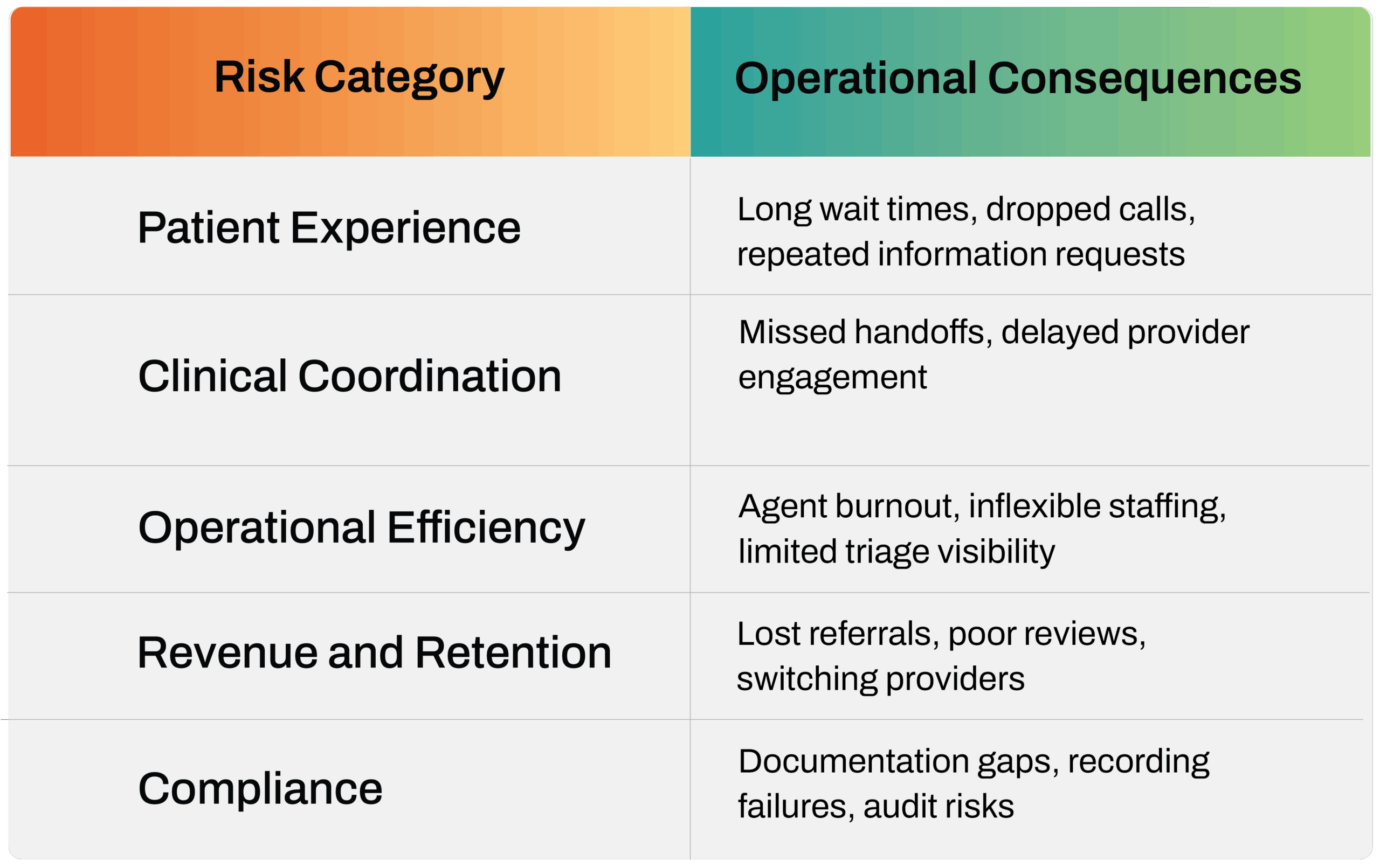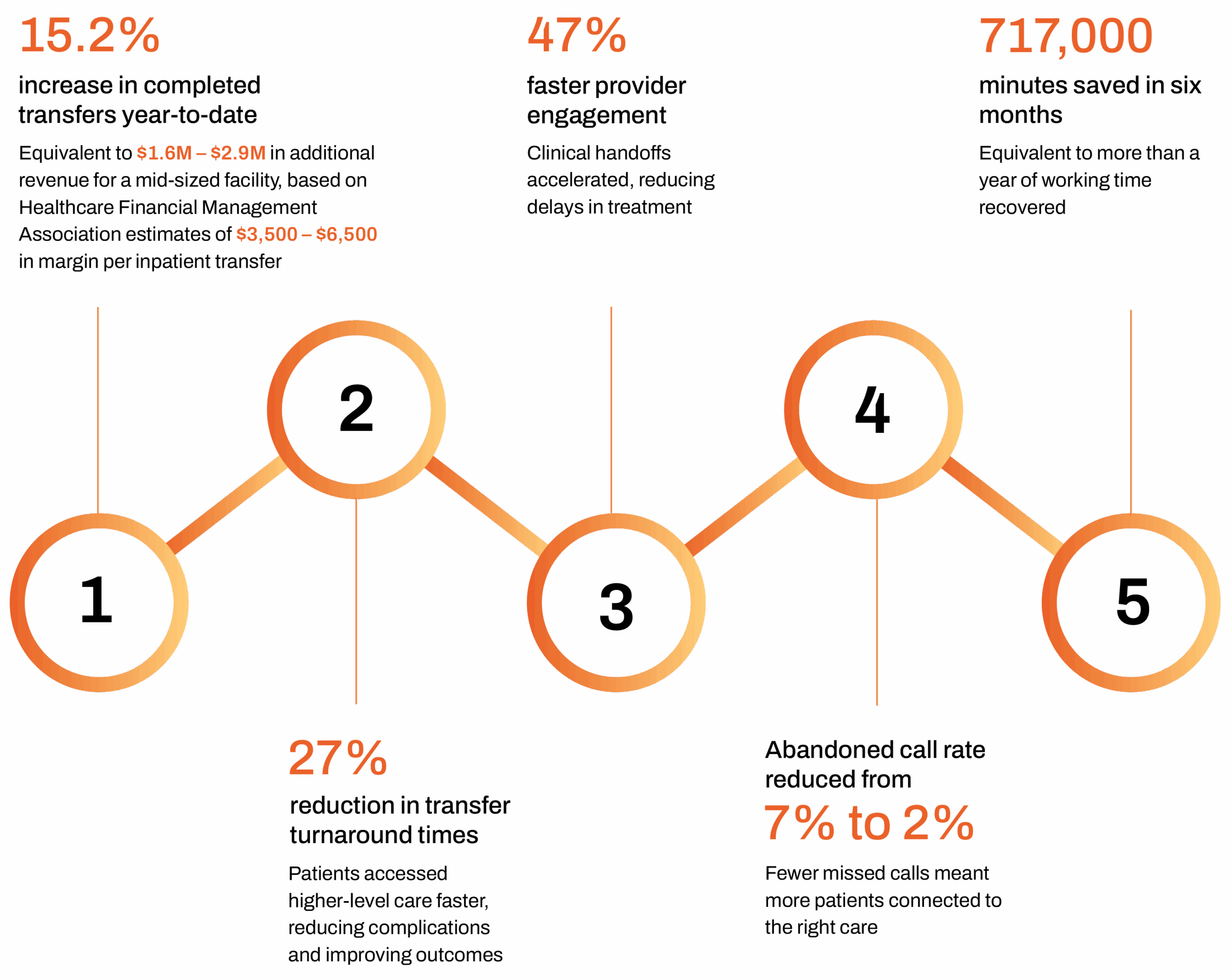In today’s healthcare environment, speed and coordination save lives. For LCMC Health, a not-for-profit system serving New Orleans, its patient Transfer Center was both a lifeline and a bottleneck. Thousands of high-stakes transfers depended on outdated phone systems, manual workarounds, and disconnected tools. The result? Missed calls, lost transfers, and patients waiting longer for the right level of care.
That changed when LCMC Health partnered with Lockstep Technology Group to modernize the heart of its transfer operations, turning inefficiency into innovation.
Why Transfer Centers Matter More Than Ever
Across the United States, hospitals face unprecedented pressure to improve outcomes, reduce costs, and enhance patient experience. The once “back-office” transfer center has evolved into a frontline performance driver, directly influencing:
- Access to care
- Clinical outcomes
- Hospital financial stability
An inefficient transfer center doesn’t just create inconvenience—it can delay treatment, increase readmissions, and impact revenue. For LCMC, the challenge was clear: transform the process before inefficiencies threatened patient safety.
The Breaking Point
Operating 24/7, LCMC’s Transfer Center coordinated transfers across eight hospitals and a freestanding emergency department. But legacy systems made this nearly impossible to manage efficiently. Calls rolled haphazardly across desks. Metrics were hard to track. Even basic call recordings required IT intervention.
“We were missing calls,” recalled Jessica Crum, Senior Director of the Transfer Center.
“Quality assurance was almost impossible. We wanted a world-class call center that could route calls properly, track metrics, and drive real improvement.”
Manual tools and fragmented workflows created a critical bottleneck, one that leadership knew could only be solved through a complete reimagining of the infrastructure.
The Risks of Standing Still
Without modernization, the operational consequences were severe:

The costs of delay weren’t just financial; they were human.
Partnering for Change
Lockstep Technology Group brought deep expertise in Cisco Webex Contact Center, Epic EHR integration, and healthcare communication strategy. From day one, the approach was collaborative, not prescriptive.
“Fixing call processing was step one,” explained Chris Favalora, Lockstep’s Solutions Architect. “But the real opportunity was visibility—giving staff control and data insights they never had before.”
Together, Lockstep and LCMC co-designed a system that fit their unique workflows while integrating seamlessly into existing platforms
Designing the New Transfer Center
The transformation began with a Cisco–Epic integrated solution powered by SpinSci. Key capabilities included:
- Smart Call Routing & IVR: Prioritized by urgency and specialty
- Click-to-Dial & Caller ID: Speeding outbound communications
- Pop-Up Note Templates: Automatically launched with incoming calls
- Call Recording Integration: Linked directly to Epic notes
- Unified Agent Desktop: Streamlined all workflows into one interface
As Crum put it: “Once we had visibility into abandoned calls and turnaround times, we could fix workflows, improve efficiency, and scale with growth.”
The Measurable Impact
Within months, LCMC’s new Transfer Center delivered quantifiable results—in both patient outcomes and operational efficiency:
- 15.2% increase in completed transfers, representing $1.6M–$2.9M in additional annual revenue
- 27% reduction in transfer turnaround time, improving access to higher-level care
- 47% faster provider engagement, enabling quicker clinical decisions
- Abandoned calls down from 7% to 2%, meaning more patients connected to the right care
- 717,000 minutes saved in just six months, equivalent to over a year of working time recovered
As Crum emphasized: “Every minute we shave off transfers means patients get to the right care sooner. Capturing more patients doesn’t just improve outcomes—it fuels growth.”

Beyond Numbers: A Cultural Transformation
Technology was only part of the story. The new workflows transformed staff experience:
- Paper tools were replaced with automated digital templates
- Agents gained real-time visibility into call metrics
- Shift-change gaps were eliminated
- Frustration dropped as efficiency soared
“We reversed the workflow so calls start with the conversation, not paperwork,” Crum noted. “Staff frustration is way down, and efficiency is way up.”
Partner hospitals now refer to LCMC’s Transfer Center as “the easy button for transfers.”
Why It Matters in Healthcare Today
This transformation aligns with the national shift toward value-based care (VBC)—rewarding coordination, penalizing inefficiency. Reducing turnaround times by 27% and accelerating provider engagement by nearly 50% directly impacts clinical outcomes and hospital sustainability
Industry data shows that 90% of healthcare organizations still lack a robust strategy for managing the patient and provider experience. LCMC’s success demonstrates what’s possible when hospitals treat the transfer center not as an expense—but as a strategic asset.
A Blueprint for the Future
By integrating Cisco Webex with Epic and building a data-driven foundation, LCMC didn’t just upgrade its technology—it redefined how the coordination of care works. Now positioned for future innovation, the organization is exploring:
- AI-driven call routing and predictive staffing
- Integration of Epic scheduling with Amion
- Secure chat enhancements for provider communication
- Advanced analytics linked to patient outcomes
As Crum concluded: “We didn’t just upgrade technology. We changed how we work. And because of that, we’re ready for what’s coming next.”
Final Thoughts
The LCMC and Lockstep partnership is a powerful example of how purpose-built technology can save time, improve care, and enhance the lives of both patients and providers. It’s not just about modern infrastructure; it’s about modern care.





